#grasshoppers and similar insects
Explore tagged Tumblr posts
Note
🍓 What is something you and the mun disagree on? (For anyone!)
Muses on the Mun

"I keep telling him bugs are delicious but he says he has a shellfish allergy and I don't even know what kind of fish have shells. Like? How is that RELEVANT? Hoot! More bugs for me I guess."
#;;hooty#fun fact if you have a shellfish allergy you should be careful eating bugs#as grasshoppers and similar insects can trigger the same response
2 notes
·
View notes
Text
Look im fine with every bug (yes even the horryfiying "SCP-006-J" ones) but what the fuck is wrong eith wasps and hornets
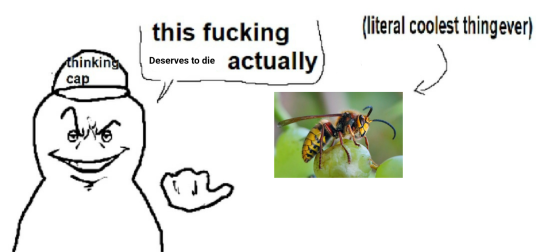
This is what bug haters look like
#bees? useful#spiders and similar? as long as they aint big its fine really (the longleg boi eats the cringe flies :3)#millipedes? CUTE#moths? YES#butterflies? the definition of Change#locusts? (lmao i almost wrote “lucists” my fingers are so fukcingn beeg) i mean they delet crops but they stopped doing that#grasshoppers and similar insects? i mean... they inspired cell dragonball?????????#stick bug bois? funky. still spooky. idk man#large insects? HORRIFYING#but acceptable#but the fucking *wasp*#*THEY ARE UNNECESSARY AND SCARY AND WHEN THEY ARE AN INVASIVE SPECIES YOU CAN ONLY GRAB POLYISTIROL AND GASOLINE*#on my#we cant expect god to do all the work#shit. call me a dalek the way i mindlessly go exterminate#AND MOSQUITOES????#*THEY HOLD FOR RANSOM THE SACRED COCOA PLANT! THEY ARE LIKE THE KINDRED FROM VAMPIRETHEMASQUERADE! CASTINGN 10000 EXPLOSIONS TO THE FOUL BLO#ODSUCKING CRINGE! KILL KILL KILLLLLLLLL*
9K notes
·
View notes
Note
Captain bogleech do you have handy references for the faces of mosquitos, fleas, houseflies, and ticks? I'm picking at an idea of a character who is themed around disease, and is strictly a source of disease and not diseased themself so like... Worlds best spreaders. The one I'm most locked on is miss aedes aegypti because of her good taste in stripes. SO in season (I dontactually know if stripes are in season)
Yes! First its good to know how a "normal" insect mouth is set up:
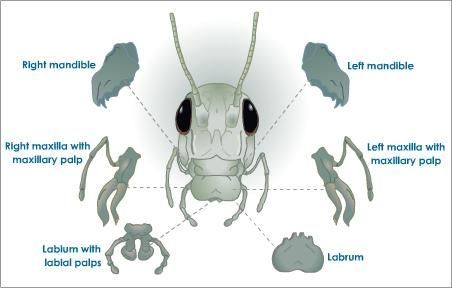
In most insects, like a grasshopper or a cockroach or the majority of beetles, there's a labrum covering the top of the mouth, kind of like a duck bill! The chompy mandibles are under that, then there are the maxilla to either side of each mandible, which include the "palps" it uses like little hands to hold food. The labium is the bottom part, and also has another set of palps! @revretch has gone into lots of detail on this but they put it best by explaining that the insect mouth is like a four sided box, formed by the labrum, maxilla and labium, with the mandibles usually inside the box. It's just that lots of insects do weird things with these parts, and many have big giant mandibles that always stick out.
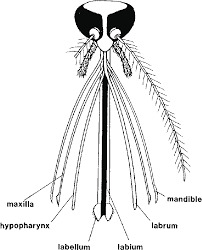

Mosquitoes have all these parts, but they're all long and thin, and they all fold together to form the proboscis, with some of them bending back as it drills into flesh.



Fleas have similar to mosquitoes, but shorter and more compact. And many species have that AWESOME looking "mustache" of thorns right above the mouth, used for anchoring to furry hosts while they feed :)

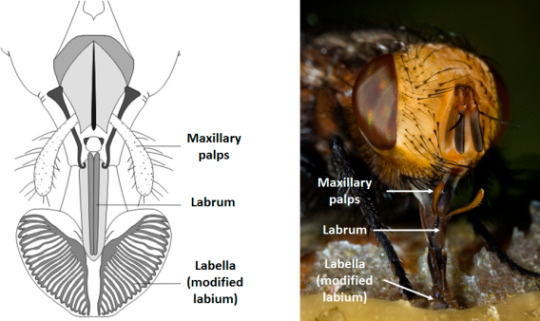
In the non-biting flies, the mandibles are GONE, the mouth extends on a flexible hose and the labella is modified into a big flaring two-lobed pad. Digestive enzymes flow down the labrum and into grooves on the pad, so it works like a sponge soaked with acid :)

Ticks are a lot different because they're arachnids rather than insects, and arachnids have fewer mouthparts; normally just one pair of palps and one pair of chelicerae, which are the "fangs" in spiders! Below all that is an arachnid's real mouth, usually just a tiny little hole. In ticks, the palps are fused into two flat flippers, which the tick uses to pinch the skin of its host. The chelicerae are formed into a pair of jagged "scissors," if the blades of scissors were on the outside! These dig in and widen a small hole. Then the mouth is surrounded by a long extension, the hypostome, which is thickly covered in sharp tiny toothlike blades. Look how rad it is:

I say this a lot but the entire part people think of as the "head" of a tick is really just the mouth, because ticks are related to mites, and in mites, the head is fused entirely with the body. So when ticks have eyes, they're here:

It's tragic the world sees ticks as fat blobs with tiny heads, when in fact they are just big heads with legs.
For fun here are some of my Mortasheen monsters that hybridize humans with all the above, though my mosquito is very dated and due for a big overhaul someday; I didn't bother trying to merge real mosquito mouthparts with fleshy human ones and just had the whole mouth spiral together:
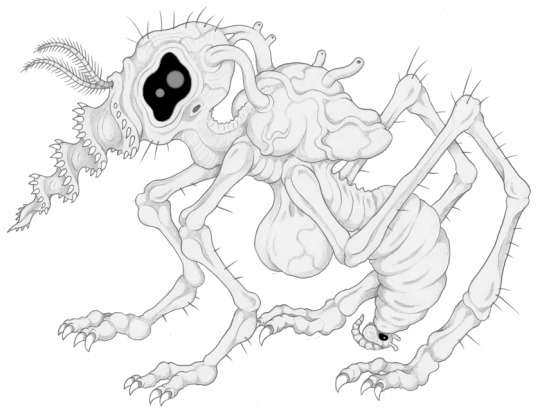
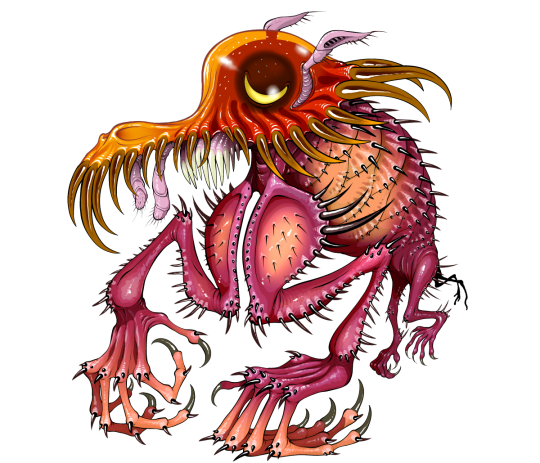



I also drew the flea without its "helmet" piece first, and went on to draw several alternate helmets :)
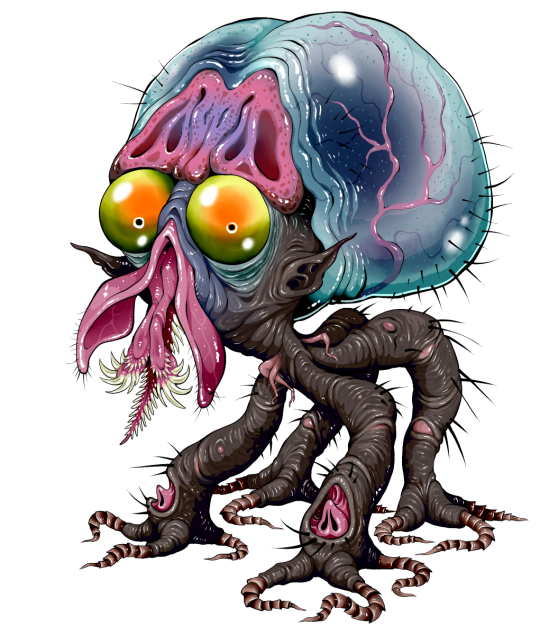
I put the most effort into the tick as you can tell. I also incorporated the fact that they smell with their front legs. :)
285 notes
·
View notes
Text





the saltmarsh sparrow is a small sparrow found in salt marshes along the atlantic coast of the united states of america. they were previously considered conspecific with the nelson’s sparrow, a similar species. sadly, saltmarsh sparrow numbers are sharply declining, primarily due to habitat loss; they are classified as endangered. the salt marsh habitat that is crucial to their survival is heavily fragmented, leading to smaller groups and less genetic diversity. during the summer, these sparrows primarily feed on grasshoppers, flies, small crustaceans, and moths; in the winter, when insects are not available, they feed on seeds. these birds are not territorial, and frequently share large home ranges with other saltmarsh sparrows. they are not monogamous, and many broods are from mixed parentage. only females display parental care; they are solely responsible for incubating the eggs and feeding and raising the young.
193 notes
·
View notes
Text


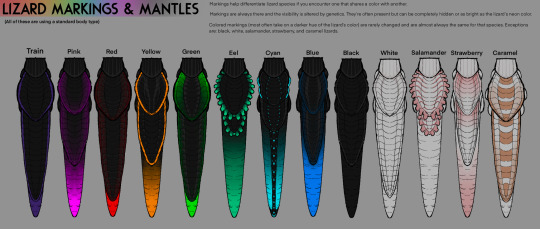

Finally got around to finishing this houugh... it was a lot of work but I really like the end result!! Naturally, I'll try my best to list some of the thoughts I have in mind for these guys below. Long post ahead!
These lizards are intended to be ALMOST fully arthropod-like but due to my lack of understanding of bug anatomy and creative liberties, they are in that gray spec bio area so don't take any inconsistencies too seriously (or rather, fuck logic, and accept them how I describe them regardless)
Inspirations: - my lesser detailed lizard design - my friend's slugcats - wasps for the head contours, various insects for the exoskeleton guidelines, caterpillars, various stylistic slugcats across the #rainworld tag - the burning need for something more detailed and cool in my drawing vocabulary
The actual meat of the post; extra facts: - Lizards are related to slugcats (in my au, if you wanna call it that?) or at least the very early version of them. This idea is borrowed from this post and in my au, lizards evolve a similar tail to a slugcat's to aid in propelling themselves through tight spaces, acting as a 5th limb. - Similar to my old vulture post, lizards share a similar lifecycle. The majority of the larval stage is spent underground and in tight spots, far from their main predator. Lizard larva will undergo pupation similar to how beetles do, leaving behind broken cavities in pipes where carnivorous plants favor to take root. Additionally to the vulture's terrible parental drive, they often mistake their own larva for lizard hatchlings. - A lizard's skin is leathery and retains moisture for quite a while. Some lizards have a thicker layered mantle than others, allowing them to take punctures to the abdomen and still recover. - Not pictured, but will be described, are a few outliers to the standard lizard body plan. Caramels have muscular hind legs akin to a grasshopper but this means their legs cannot slot together and thus they have a wider leg splay than other species. Eels and salamanders are not lizards but lizard mimics. Yellow lizards' antennae attach to a hump on the snout rather than the rear of the head as seen here. Cyan lizards' mantles are more square shaped due to their leap drums on either side of their bodies and have a 3rd mantle that runs the length of their tail and caps the tailtip. - Cyan lizard's organs are called leap drums and act similarly to our lungs. They are a ring of muscle which contracts and acts as a spring loaded mechanism to propel the creature via combustion through a mysterious chemical process. Because the color of debris left behind during a leap share the same color as the lizard, perhaps they are discarded scales, formerly in place to protect the cavities housing the explosion. - They have similar organs to vertebrates within their abdomen, probably surrounded by cartilage. (not that important, I haven't thought that much about this) - (More may be added later as I remember)
#myart#rainworld#rainworld lizard#rain world lizard#rw lizard#bug#insect#bugs#insects#rainworldbuilding
2K notes
·
View notes
Note

Hello! found this very small and fast guy in my bathroom and am very curious as to what he is! the body was maybe 1/4 of an inch long and the back legs bent in a similar way to a grasshopper, difficult to see in this photo. Spotted in Portland, Oregon
Insect ID - OR, USA:
Hello, yes, at this size I can probably not get it down to a species, or even a genus definitively. It is definitely the early instar of a katydid nymph, family Tettigoniidae.
It looks very much to me like the nymph of a meadow katydid, genus Conocephalus, but I can';'t be sure from this photo.
55 notes
·
View notes
Note
Why do Bees have five eyes.
There are a few hypotheses as to why the extra, simple eyes of insects are a thing, from aiding their sense of direction, to head stabilization, to motion tracking/sensitivity.
Bees have two compound eyes that are capable of true sight, followed by three ocelli (or simple eyes) capable only of simple sight (in most cases) in the form of light detection, in the middle, on top of their heads! But they're not the only ones, all Hymenopterans including sawflies, ants, and other wasps have these three eyes.
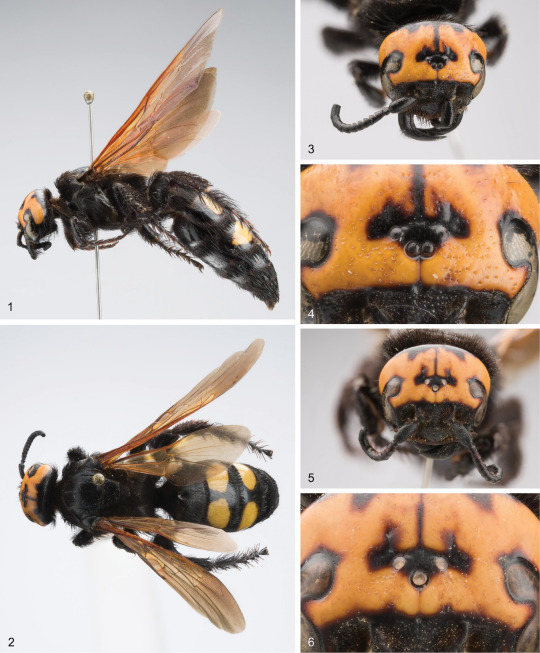
[Image Source: Pensoft, Matthias Haase | Image ID: Five different views of two black, orange, and yellow Scoliid wasps, the images on the right showing its ocelli prominently /End IDs.]
Most other insects also have these simple eyes, from one to three, if not through their whole life then at the very least in their youth, barring some insects that don't/rarely fly or are blind/live in caves, among others. Lepidopterans (moths, butterflies), beetles (mainly in youth apart from certain species), silverfish, flies, orthopterans (grasshoppers, crickets, katydids), dictyopterans (mantises, roaches/termites), hemipterans (stink bugs, assassin bugs, cicadas, planthoppers, etc.), stick bugs, lacewings, mayflies, odonata (dragonflies, damselflies), etc etc etc I could probably go on but for the sake of tedium I'll leave it there. All of these have ocelli in many maaany (but not all) of their species.
A few of these, like mantises and cicadas, have them in quite a similar structure to the way the hymenopterans have them!
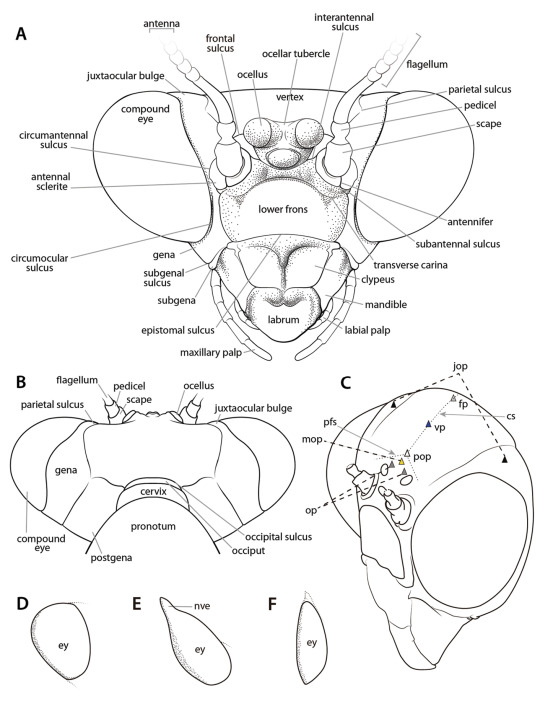

[Image Sources: Pensoft and Flickr, Barbara Eckstein | Image IDs: An illustrated diagram of the head of a mantis, followed by an up close photo of a green, black, and yellow cicada's head, showing its red ocelli /End IDs.]
Insects aren't even the only ones with extra simple eyes, some crustaceans and myriapods have them (among other arthropods), as well as some lizards, tuataras, and more.
56 notes
·
View notes
Note
I don’t know if this blog is still active, but I would like to know if there are known Sumerian words for insects, coakroaches, and spiders. Thanks
Hello! Here's some vocabulary that may be of interest to you.
The most general term for insects, bugs, and creepy-crawlies is umun 𒄯𒄯. There's also the potentially onomatopoeic term eh or uh 𒄴, "bug, moth, louse, flea, parasite", which is also the verb for "to have lice". Nim 𒉏 means "fly" and is the root of nimlal 𒉏𒋭 "bee". Kishi (written 𒁞 in cuneiform among other signs) means "ant(s)", and there are several words for "locust", including bir or buru 𒉆. Mar 𒈥 means "worm" or "parasite" more generally.
Unfortunately, insect vocab falls victim to the same issues of many other categories of words in Sumerian - that we know a lot of words for different bugs, but not which word means which bug. That means a lot of words have disputed meanings. Halloran (2006) has shurun 𒁨 for "cockroach" or "cricket", while the ePSD lists it as "cricket, grasshopper". Kuzazu 𒆪𒍝𒍪𒄷 is some sort of "wasp or flying insect", while ubshukur 𒌒𒉻 might mean "centipede" or a similar bug. And sharan 𒁙 is just "an insect" in the ePSD, but Halloran lists it as "tick, bedbug".
I've previously answered about "spider", which is ash, written 𒋠𒇴𒋦 in cuneiform. And do check out my prior posts on butterflies & moths and the hunt for the word for "bee", as well as my Sumerian animals tag in general. Enjoy!
27 notes
·
View notes
Text
52 notes
·
View notes
Text










Two-Striped Grasshopper - Melanoplus bivittatus
Upon first noticing this conspicuous insect in the front yard, I had to double-take, and I'm glad that I did, otherwise it would've been overlooked as a wonderful find. Typically there are dozens of Red-Legged Grasshoppers that bound about the yard in the later stages of summer, and given the similarity to the Two-Striped Grasshopper, they can be easily mistaken for each other. It certainly doesn't help that the Two-Striped specimens also have a set of red-colored tibiae that allow them launch into the air with tremendous force. Between the two Melanoplus Grasshopper species, you can tell them apart an amateur's glance by taking into consideration their size and their dorsal side. The Two-Striped Grasshopper is typically the larger specimen (to a substantial degree) and it features two wide stripes running down its back from its eyes to its wingtips. Simple enough! For the best look at these stripes, carefully examine Picture 5 as it basks in the sun while grasping a car door. These yellow stripes are most prominent during the Grasshopper's adult stage, but also appear in the nymph instars, making the distinction between Red-Legged nymph and a Two-Striped nymphs difficult for me.
Given this Grasshopper's large size, you can bet that it's a hungry vegetarian with a taste for grass, leaf, forb*, and greenery. While one individual isn't tasking, a large group of these Short-Horned insects has the potential to contribute to status as a pest while they ravage crop fields. From my understanding, aggregations of this specie is infrequent, but when they occur, the damage to plants can be quite substantial. It has been reported to favor alfalfa, cereal crops (such as corn) and some varieties of wheat and vegetable. They defoliate the plants they feed on in a wasteful fashion, and may even go so far as to consume parts of their flowers too! Thank goodness outbreaks are infrequent, especially given that the Two-Striped Grasshopper has to keep gorging plants throughout its lifecycle to remain satiated and healthy. However, it will not lay eggs on or too close to the plants it feeds on. Rather it will jump away to crop borders, empty soil and even the sides of roads to place the eggs in that ground. Thusly the cycle goes on, and growers and gardeners thusly have to keep aware of 1 of 2 subspecies of Two-Striped Grasshoppers leaping about the fields and meadows. The presence of one of the subspecies varies by North American region, with one being found in innermost dry regions, and the other one elsewhere. M. b. bivittatus is the former, while M. b. femoratus is the latter, and what I think this individual is, as it is mostly green with red hind tibiae and it doesn't have a strong black stripe on the top half of the hind femur's front.
Pictures were taken on August 20, 2020 with a Google Pixel 4.
*Note: A forb is a flowering plant that is not a grass or sedge which also lacks a wooden stem. Milkweed, for example, is a forb, but this Grasshopper specie wouldn't be able to eat it due to the toxic sap. Edible forbs on the other hand can provide the nymphs with ample nutrition to facilitate healthy growth. Forb is is also a fun-sounding word, and deserves more use in the public lexicon.
#jonny’s insect catalogue#ontario insect#grasshopper#two striped grasshopper#orthoptera#insect#toronto#2020#august2020#nature#entomology#invertebrates#arthropods#photography#animals
15 notes
·
View notes
Text

This is Esmeralda.
During uni, as an exam, our professor requested an essay in which we had to describe a system applying all the biochemistry stuff we'd learned. I chose her as an species and my head hurt so much i questioned why would people think a person could have created a whole world with ecosystems and living beings. i know gods aren't people, but ough, that should be tricky.
Anyways, her design is too different to the first one up in her rider's profile, so i should remake his too. unu. but i'm happy how it came out!! She doesn't have as much speculation as Dorado does, but honestly I rushed this. I might make a species sheet for her, since I started thinking about the differences between males and females and that essay must be worth it.
[ID: a character sheet of Esmeralda, a fictional amphibian explained as a flying newt. She's has the body of a bright green newt, feet like a gecko's and two pair of wings, the front ones are slender and the back ones are similar to a butterfly's, although wings displayed like this are found in real life grasshoppers. She also has two pairs of eyes. From left to right, there are illustrations of her taking fllight as she jumps from a tree trunk with her wings spread out; her flight silouette; a side view; a drawing in which she has her saddle on, and a half body drawing of her openning her mouth, which is purple on the inside.
There are text boxes that explain some of her characteristics. First, her scientific name reads "Rhyacotriton smaragdus"
From left to right, the texts says:
Wings like a grasshopper's. Undersides are paler, similar to a butterfly's.
Flight silouette (top view)
Bothe eyes are functional. The smaller ones tell distance since they're at the front.
Wings are saved like an accordion.
Saddle. Made light to facilitate flight. The helm can be displayed horizontally for climbing trees.
Feet can adhere to all surfaces in the jungle. Her species is less dependant on water but they still hunt near it. They have developed hard structures (claws and spikes) for defense out of the water.
Aileron is displayed transversally when flying (see Flight silouette).
They shoot their tongue to catch prey (giant insects).
Her species not being a 'true dragon' doesn't stop her from making loud noises for fun. End ID.]
#irbis draws#art#digital art#ocs#my ocs#esmeralda oc#guskoy#speculative biology#spec bio#salamander#dragon#figuring out her anatomy was a challenge as always but i finally liked the result
27 notes
·
View notes
Text
JTTW Chapter 72 Thoughts
Chapter 72 for the @journeythroughjourneytothewest Reading Group!
Spiders do retract their webs in a sense, usually by eating them, so the spider ladies doing that but in a more magic way is accurate.
The seven son’s have slightly different names in the original Chinese though they are mostly one character of their species. Only for three of these guys did I find a clear translation, the other four are approximations at best or whole mysteries.
Bee is actually called Honey there, which is pretty cute! He is a honeybee or Apis which is the genus of honeybee specifically. Funfact every species of honeybee except the Western Honeybee or European Honeybee is native to South and Southeast Asia! Also either he is specifically a drone or we might have a potential accidental trans character here since worker bees are girls only!

Hornet, correct! Could be wasp too though, it is a bit unclear but same-difference really. Just the first character of that, which is their name, can apparently also translate to ‘darning needle’? I headcanon their name as Needle now which fits the insect. Though that character is primarily part of various insect names mostly of the Hymenoptera order which encompasses quite a few types of insects such as wasps, bees and ants.
Cockroach, no? This one seems to be a wasp? Again quite unclear, but my conclusion is Hornet is a hornet and Cockroach is actually a wasp. As for their name, the first character alone does not have a translation apparently? I tried more than one translator too and nothing came up. So their name is a mystery.
Cantharis is a total mystery. It contains the character for fur, so I’m assuming it is at least a fluffy insect.
Grasshopper, this one is much clearer again, yes! His name is Grasshopper and he is a grasshopper. My headcanon name for them is shortened Hopper, a cute name.
Maggot, that is another complete mystery. Though the character for their name seems to translate to wax? So their headcanon name is Wax now, which I could see as the name of a particularly waxy insect.
Dragonfly, yes. A dragonfly named Dragonfly, simple.
The important point in the text just seems to be that it is seven kinds of insects, which the translation did rather well.
“The sky full of flying maggots, The ground covered by dragonflies” are we sure about that? Maggots do not fly, it would make a lot more sense to swap them out with those dragonflies. In the original Chinese both kinds of insects here are just in the air it seems. The German translation has some fun with this too, similarly to the Chinese original text they use the first syllable as each bugs name. The order of insects is bee, same as everywhere else, wasp which is close enough, a more general term for a crawly bug like a bedbug, then a caterpillar, then the hornet, then a grasshopper and lastly a dragonfly. So all in all pretty similar to both other translations I looked at, if in a slightly different order.
7 notes
·
View notes
Text
Mary Oliver's "The Summer Day" through Miyazaki's realm
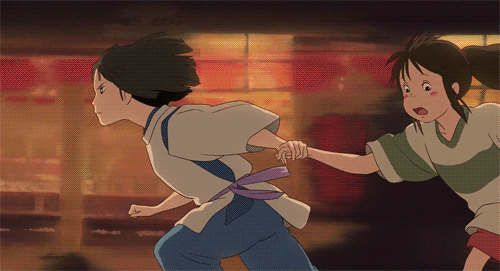
Who made the world? Who made the swan, and the black bear? Who made the grasshopper? This grasshopper, I mean — the one who has flung herself out of the grass, the one who is eating sugar out of my hand, who is moving her jaws back and forth instead of up and down — who is gazing around with her enormous and complicated eyes. Now she lifts her pale forearms and thoroughly washes her face. Now she snaps her wings open, and floats away. I don't know exactly what a prayer is. I do know how to pay attention, how to fall down into the grass, how to kneel down in the grass, how to be idle and blessed, how to stroll through the fields, which is what I have been doing all day. Tell me, what else should I have done? Doesn't everything die at last, and too soon? Tell me, what is it you plan to do with your one wild and precious life?
Mary Oliver
The Grasshopper as a Symbol of Presence

The simplicity of a summer's day often masks the depth of reflection it can inspire, often a freer inspiration compared to that of another time period. In The Summer Day, Mary Oliver records a fleeting moment with a grasshopper—an otherwise mundane event turned into a profound ponderment of life's transience. Oliver's fascination with the grasshopper is evident in her precise observations, where each "Now" anchors us in the immediacy of the creature's actions. The repetition of "Now" is a rhythmic reminder to fully engage in the present moment, elevating the grasshopper's simple acts—washing her face and eating sugar—to moments of sacred significance. This suggests that even the most ordinary experiences, when viewed with a mindful eye, are imbued with a profound beauty and wonder.
A crucial aspect of this reflection is Oliver’s decision to refer to the grasshopper as "her," a subtle yet powerful choice that humanises the insect (one typically discarded, much like other insects) and invites readers to see it as a mirror of the poet herself. This connection is deepened as the poem shifts from observing the grasshopper to the poet’s own introspective, almost existentialist state. The grasshopper’s simple, technical existence, is paralleled by the poet’s own acts of kneeling, strolling, and paying attention, among other acts (otherwise seen as mundane).
With its gentle meditation on nature, this poem resonates with the themes explored in Hayao Miyazaki's Spirited Away, particularly in the scene(s) accompanied by the casually melancholic, world-renowned score, One Summer's Day.
Why The, or One, Summer day?

The difference between the singular summer day in Mary Oliver's poem and the more common references to "summer days" marks a shift in tone and thematic focus. Oliver creates a space for deep contemplation and reflection by honing in on a single day. This singular day is a moment of intense focus where the reader is invited to take note of immediacy and transience of life, and what it means on an individualistic scale. The title 'The Summer Day' suggests a specific, significant day, much like the small yet detailed, pivotal moments in 'Spirited Away' that shape the narrative and the characters' experiences. One summer day can shape the entire summer season, just as one significant event can shape an entire story or life.
In contrast, when summer days are referred to in the plural, as is often the case, the tone tends to shift toward a more upbeat, joyful (collective) celebration of the season. This plural perspective generalises the experience of summer, allowing it to stretch over time and encapsulate the season's qualities as a whole rather than the intensity of a singular, reflective moment which we all experience—differing in frequency, consciousness, and extremity.
The tone of the poem is one of peaceful contemplation, with an undercurrent of melancholy as the speaker reflects on the transient nature of life. A truly specific feeling. This mood is similar to the tone of One Summer's Day, where the music and imagery in Spirited Away evoke a sense of longing for something that is just out of reach, something beautiful yet impermanent.
(A) Summertime Sadness?

The specificity of The Summer Day underscores the fleeting nature of time and the urgency of living fully, urging the reader to consider how they spend their "one wild and precious life." The repetition of "Tell me," despite the shift from passive observation to active questioning—from "Tell me, what else should I have done?" to "Tell me, what is it you plan to do"—suggests that the same forces that once pacified us can be reclaimed and turned into active, assertive intentions, forming a balance. This emphasis on autonomy starkly contrasts the capitalist ideals that prioritise efficiency and forward planning over present mindfulness. The context of nature's beauty and the existential questions it inspires is particularly poignant.
One must embrace the Present

The poem’s structure mirrors the unhurried pace of a summer’s day. Its free verse form allows the poem to flow naturally, much like the spontaneous movements of the grasshopper. This lack of structure reflects the poem’s theme of living in the moment—there is no rush, no pressure to conform, only a gentle observation of life as it unfolds. The poem’s tone, gentle yet profound, stresses the urgency (as opposed to the usual, stressful urgencies of society) of embracing the present and finding meaning in the small, often overlooked details of life.
This theme is further emphasised when considering the role of capitalism in Spirited Away. The film critiques the dehumanising effects of a society driven by greed, where even inward things, such as names—symbols of identity and connection to the self—are commodified. No Face, a mysterious and initially innocuous spirit, becomes monstrous as he consumes more material wealth, embodying the destructive nature of greed. His obsession with Chihiro reflects a desperate, almost uncontrollable desire to connect with something pure in a world corrupted by excess.

Both works ultimately remind us that our differences from nature do not separate us from it; instead, they are what bind us, offering life lessons that transcend the human experience.
After all, would Chihiro have survived if she hadn't hidden her name, thereby protecting her identity and her parents'? Would she have even recognised the importance of holding onto her name without Haku's guidance? Why does Haku return to his complete dragon form rather than becoming fully human, as is often the case in tales of human-creature transformations? Would she have become yet another template of a character in Miyazaki's realm? Art compels us to ask these sorts of questions—questions that deepen our understanding not only of the works themselves but of life


There lies the beauty of art and its interconnected nature; we must fully appreciate poetry by reading novels and critical essays, watching films, wholeheartedly listening to their soundtracks, and engaging with countless other forms of creative expression.
#literature#thoughts#poetscommunity#poetry#poem#writers and poets#academia#journalistic writing#quote#hayao miyazaki#studio ghibli#spirited away#one summer day#mary oliver#nature#nature poetry#nature poem#art#anime#animation#anime review#review#capitalism#life lessons#absurdism#philosophy#original post#summer#music#summertime sadness
66 notes
·
View notes
Text

Name: N/A
Race: Sigmaloid
HT: Ranges from 5’7” at smallest to 6’6” on average
WT: Ranges from 126LBS to 200LBS
Cock: Medium to large 14.50” full length with 13” insertable, smooth with humps
Description: The Sigmalites of Cylust 9 are an insectoid humanoid species in the outer rings of the Milky way, they’re Homeworld is actually made of two planetoids circling one star similar to our Sun, but with the planets having a cyclical orbit they’re weather remains consistent throughout the planets surface see Roche limit theory. The species isn’t able to master human languages but sign language and pantomiming has proven successful in intergalactic communication efforts! A surprising spry and light weight species they have very similar human builds in body, with exoskeletons and internal anatomy like our own insects. The primary species seems to be a cross between a praying mantis, grasshopper and other variations of locust like insects from Earth. A highly scientific advanced species they have mastered lightspeed travel and enjoy Earth’s more humid and temperate climates to visit. They do not function in cold weather, as it will make them hibernate. Similar to cicadas they lay their eggs underground on their planet and will not see the new generation of brood for at least 17 Earth years. Once they burst out of their brood horde underground they are full sexual maturity and return to their families. Ranging from large cities to smaller communities that seem to be for elders ready to retire, they do not seem to stop engaging in sexual activity with age, leaving for a large and robust population. Human and Sigmaloid interactions have proven peaceful, beneficial and exciting. They’re hour arms leave no skin or hole unexplored and with such light bodies they are gentle lovers when with much squisher Humans. They’re textured cocks seem to be withdrawn into a cloaca like sheath with upon arousal extend to desired length, it seems sizes can vary depending on receiving partner’s capability. This unique ability seems to leave no one unsatisfied and there are even full inter-species relationships established on both Earth and their home world of Cylust 9. Further studying is required on this researcher's part.
#tw teratophilia#terat0philliac#illustration#mrhankeystoys#hankeystoys#monster x reader smut#monster smut#alien species#aliens and ufos#alien lover
20 notes
·
View notes
Text

Lost and Found: an A Bug's Life story
Chapter Four: The Council
(haven't read any of this story yet? start here!)
~
The bang of Atta’s gavel echoed throughout the council chamber. It was a sound rarely heard these days, similar to the almost forgotten bellow of snail horns that had once warned Ant Island of Hopper’s impending arrival. There was no need for those horns now that the grasshoppers were gone.
In fact, there was hardly even a need for council meetings anymore.
These days, Flik and Atta made most of the major decisions affecting the colony between the two of them, behind closed doors. Once they came to an agreement, they then brought their proposal to the individual council members for their signatures of approval. In addition to the queen, the royal council consisted of five members: Thorny, Cornelius, Soil, Flora, and—as of almost four seasons ago now, shortly after the Queen’s passing—Manny.
It was a system that worked well for everyone. No one missed those chaotic meetings of the past, when everyone talked over everyone else for two hours straight only to end up with almost nothing to show for it.
Today was an exception.
Today Atta had called an emergency council meeting, the first one held since Flik himself stood on trial for upsetting Hopper’s offering (and subsequently upsetting Hopper himself) two springs ago. Today the six insects were gathered beneath the achingly bright mushroom that served as the chamber’s light source, and their purpose was not to discuss agricultural policies or trade agreements or fund allocation.
Boring as those topics were, Flik would have preferred any of them over the reason this meeting had actually been called.
Thorny’s gruff voice broke through his reverie.
“So what happened to her?” he demanded, his tone almost implying that Atta herself had something to do with Dot’s disappearance. “Where on the Island could she have gone?”
A long pause followed the engineer’s question. For the first time since the meeting started about twenty minutes ago—when Atta uttered the words “missing princess” and the room devolved into mayhem—the council chamber was silent.
All eyes were on the queen.
Flik knew with one glance at his wife’s pale face that she was doing everything in her power not to cry. Her lips were pressed together as she stared down at the gavel in her hand, her chest rising and falling with measured breaths. All he wanted was to stand up, march across the room, and wrap her in a hug.
But he couldn’t. As prince consort, his job was to sit on the former queen’s throne, try not to think too hard about how much he wished it was his mother-in-law still sitting here instead of him, and give a thoughtful hum every so often as he watched the council proceedings unfold.
Oh, and to hold Aphie. Since the aphid’s former owner wasn’t here to do it herself.
Flik watched his wife’s pregnant belly grow even bigger as she took another deep breath. Her hand was splayed over it, like she was trying to shield the baby inside from the news she was about to deliver.
“We have reason to believe that Dot was taken captive by an enemy kingdom.”
continue reading ->
image credits linked in comments
#a bug's life#pixar#disney pixar#pixar fanfic#pixar fanfiction#post canon#flik#atta#dot#princess dot#personal#disney fanfic#disney fanfiction
9 notes
·
View notes
Note
What about:
Tikki X Pollen
Nooroo X Tikki
Pollen X Nooroo
Do I have a treat for y'all:

First up, Tikki and Pollen, making a firefly. Why? I just liked it for these two.
The power and concept. The concept came first as, well, an instant reaction of what to call them. The powers came later that draws on Venom, but instead they can create a kinetic field that absorbs movement within, bringing everything and anything within it to a stop.

Second, Tikki and Nooroo. This was a little difficult and the last of the insects just to find one that felt fitting. I was going to lean towards a grasshopper or a locust, but stumbled upon the mantis again and the beautiful varieties in the flower mantis. So, I picked the Orchid Mantis because it was the one I could stomach looking at.
The power and concept. The concept of Instruction comes from the power of power programing. Blood Orchid can give substance to a power of her choosing and program it to act as to be instructed.

And, lastly, Pollen and Nooroo. I went with a Bee Fly as it is a fly that looks very similar to a bee, but isn't a bee. Kinda like how some butterflies and even moths will mimic the environment to hide or ward off threats.
The power and concept. The concept of accumulation comes from the power being power accumulation. Over the course of five minutes, Bomb Fly can accumulate power before she unleashes it
I also realize I forgot the brooch on Bomb Fly, but eh. It's whatever.
#miraculous ladybug#miraculous#miraculoustalesofladybugandcatnoir#miraculous au#au#alternate universe#fanart#miraculous fanart#digital art#design#ml fusion#bloody bug au#bloody bug#bomb bee#alya cesaire#alix kubdel
20 notes
·
View notes